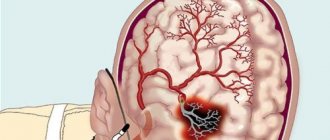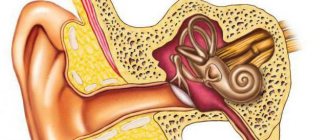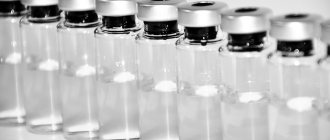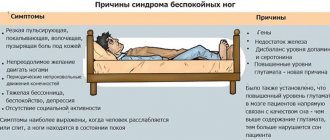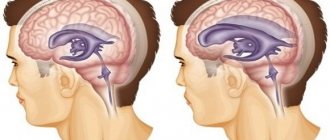One of the main problems in neurology and neurosurgery today is considered to be a violation of the blood supply to the brain of both acute and chronic origin, leading to temporary or persistent negative consequences for the patient. This is due to damage to various brain structures (neurons of the cortex, subcortical and stem formations) due to a deficiency of nutrients and oxygen, which cannot be fully and sufficiently delivered to the area through pathologically altered vessels. One of the most difficult in terms of prognosis for the health and life, treatment and rehabilitation of the patient is acute cerebrovascular accident (usually abbreviated as stroke in medical documentation), in which transient (transient) ischemic attacks develop, and there is also a high risk of ischemic stroke ( heart attack) or hemorrhagic type (hemorrhage).
Causes of stroke
For the development of this pathology, reasons are needed that change the structure and tone of the capillaries, interfering with the full delivery of blood rich in oxygen and nutrients to the brain. The main risk factors are vascular pathologies (aneurysms, vasculitis, atherosclerosis) or arterial hypertension, especially with a crisis course.
Even before serious problems develop, it is possible to identify minimal manifestations typical of atherosclerotic lesions of veins and arteries. These include sleep disorders and headaches, decreased performance, especially in the evening, periodic dizziness and a feeling of noise in the head. Irritability and nervousness may occur; strong emotionality with sharp transitions from joy to tears; decreased hearing and memory; absent-mindedness; decreased concentration; periodically occurring unpleasant sensations on the skin in the form of tingling, crawling.
Symptoms of neuroses - asthenic, hypochondriacal or depressive - are common.
Dangerous in terms of strokes or transient ischemic attacks are becoming more frequent hypertensive crises, leading to a sharp spasm of blood vessels, a disorder of the water-electrolyte balance and rheological properties of the blood (it thickens, becomes viscous, and flows worse through the capillaries). The listed pathological changes lead to stimulation of the adrenal glands, which increases the release of vasopressor (constricting) factors, which, in turn, contributes to the development of temporary or permanent vascular spasm.
The presence of vascular pathology, disturbing symptoms, and poor health is a serious reason for starting preventive treatment in order to prevent the acute form of the disease.
Acute cerebrovascular accident: development of pathology
To understand what stroke in medicine is, it is important to determine how the brain is supplied with blood and which failures of the circulatory system are the most dangerous. The cervical arteries supply oxygenated and nutrient-rich blood through the foramen magnum into the cranial cavity. The entire organ is densely intertwined with a network of arteries and veins with capillaries extending from them, which allows the neurons to be fully supplied with blood. Each branch of the artery has its own area of responsibility, and through the veins the blood flows from the head, gradually collecting into large vessels.
Both interruptions in the flow of blood through the arteries and failure of the outflow of blood through the veins (so-called stagnation) are dangerous. Typically, acute cerebral circulatory failure occurs in cases where the arteries are damaged and rupture with bleeding or blockage with severe spasm and ischemia of a certain area. Venous problems are more typical for the chronic course of pathological processes due to stagnation of blood in the arteries and veins and a slowdown in the outflow rate.
Just three minutes
Acute cerebral ischemia is the third and fifth cause of death in men and women aged 60 years and older. According to global epidemiological studies, most of those who survive are left with walking, speaking, hearing and cognitive problems (that is, attention, thought and memory), depending on the area of the brain that has lost blood supply.
Once the blood supply to the brain is interrupted, neurons survive for only three minutes, no more. If blood flow is not restored, neurons begin to die. It turns out that the prognosis depends on the speed of assistance.
What is acute stroke with persistent impairments?
At its core, an acute cerebrovascular accident is a sharp discrepancy between the volumes of incoming blood, bringing oxygen and nutrients to the tissues, with the existing needs. Such a dangerous situation arises as a result of persistent ischemia of a certain area of tissue as a result of severe spasm or blockage of the lumen by a thrombus or embolus. Ischemic stroke develops through this mechanism. Another option for interruption of blood circulation, which may result in damage to the brain, is rupture of capillaries with leakage of blood into the tissue, hemorrhage with the formation of a hematoma or an area of hemorrhagic impregnation. Both options refer to persistent circulatory problems.
How to prevent the disease?
Acute cerebral ischemia is a complete or partial reduction in blood flow to a specific area of the brain as a result of a thrombus (a blood clot that forms inside an artery or vein) or an embolus (solid, liquid, or consisting of gaseous bacteria, a fat droplet, or an air bubble). An embolus can become lodged in a smaller artery or vein and impede blood circulation.
This decrease in blood flow means that oxygen and glucose do not reach the neurons. This may explain the cognitive and behavioral changes caused by acute cerebral ischemia.
When the blood supply to the brain is interrupted, neurons survive for only three minutes, no more. If this irrigation is not restored, neurons begin to die. Risk factors for this disease primarily occur in the sixth decade of life and include hyperlipidemia (high levels of fats in the blood) and hypertension (high blood pressure).
It has also been observed that frequent consumption of alcohol and tobacco, drug abuse in general and the use of contraceptives can contribute to the formation of blood clots and, as a result, cause acute cerebral ischemic attack.
Additionally, when a person suffers a cardiac infarction, the heart stops pumping enough blood to the brain, resulting in an ischemic process that can lead to cerebral vascular stroke.
As already stated, this disease usually appears at age 60 and, although it is rare in young people, people with obesity, hyperlipidemia and hypertension are susceptible to it.
The unexpected presence of a nervous eyelid tic can also be alarming. Disorientation and trembling are possible. The duration of treatment aimed at reducing the damage from acute cerebral ischemic attack is very short: three hours. In fact, the only drug used today in the clinic is prescribed only for those three hours that are counted from the moment the stroke occurs, because after three hours the drug, instead of helping, can harm the person.
What is a transient stroke?
As a result of sudden and relatively short-term effects, transient disorders associated with temporary but pronounced vasospasm can develop. If we talk about transient circulatory disorders, what they are can be understood by knowing the basic mechanisms of their formation. This is a temporary spasm of the capillaries in the head, caused by various unfavorable external factors or internal pathological processes, leading to the formation of a certain set of negative symptoms. Neurological manifestations of spasm persist for several minutes or hours to a day, followed by complete restoration of all impaired functions.
Such conditions are classified as pre-stroke; they require special attention from doctors and patients themselves, since without adequate treatment and elimination of all the causes leading to this anomaly, such failures threaten the development of a stroke in the future.
The most common causes of TIA (transient ischemic attack) are the following:
- arterial hypertension with a crisis course, against the background of which sharp spasms occur;
- atherosclerotic damage to the walls of capillaries, leading to a narrowing of their lumen, due to which blood flow to the gray matter of the brain decreases;
- cardiac arrhythmias that impair blood circulation, including the head area;
- heart failure or acute vascular collapse.
It is not difficult to describe transient acute disorders of cerebral circulation and what they are in terms of manifestations. All symptoms can be divided into:
- general cerebral;
- focal.
General cerebral symptoms:
- the appearance of a sharp and severe, painful headache with dizziness, attacks of nausea and vomiting;
- short-term loss of consciousness or a feeling of stupor, disorientation of the patient in space and time are possible.
Focal symptoms:
- the occurrence of temporary paralysis and paresis (partial paralysis of a separate zone), as well as a feeling of crawling (paresthesia);
- visual disturbances with flickering dots, flashes of light or spots;
- various speech disorders;
- problems coordinating when walking or moving limbs;
- non-compliance with the functions of individual nuclei of the cranial nerves (problems with opening the mouth, blinking the eyes, swallowing).
If the diagnosis of a transient circulatory disorder is made immediately, and active professional treatment measures begin to eliminate the spasm, restore normal blood flow, and a competent fight against arrhythmias and hypertension is carried out, then the blood supply is restored, and all negative symptoms disappear within 24 hours without consequences. If such manifestations are ignored or self-medicated, more serious pathological conditions - strokes - can occur.
ACVA, cerebral stroke: what is this diagnosis?
In the presence of persistent circulatory disorders of the brain, long periods of bleeding of certain areas are formed with progressive death of neurons and the formation of an area of tissue necrosis, which forms a cerebral stroke.
If we are talking about a diagnosis of a persistent disorder, what does this mean from a clinical point of view? This is the formation of severe disorders and severe symptoms, up to a coma and death of the patient from increasing respiratory and vascular disorders.
Thus, patients with stroke are people who have experienced a hemorrhagic stroke (hemorrhage due to capillary rupture) or ischemic stroke (irreversible blockage by a thrombus or embolus, persistent irreversible spasm of an atherosclerotic vessel).
Rehabilitation activities
In addition to drug treatment, it is necessary to carry out a set of rehabilitation measures to restore motor function and prevent the development of contractures. For this purpose the following is used:
- massage;
- physiotherapy;
- breathing exercises.
Alternative treatments:
- acupressure;
- aromatherapy;
- hirudotherapy;
- pine baths;
- oxygen baths.
To restore motor functions and motility, a course of kinesitherapy is indicated. It is used in the early rehabilitation period and consists of activities aimed at restoring coordination of movements and motor activity by stimulating reflexes. Microkinesitherapy is used - a therapeutic effect on the body through micropalpation, the purpose of which is to activate self-healing processes.
Rehabilitation of patients takes a long time, which, with a favorable course of the disease, takes several years to return to their usual way of life. However, full recovery is almost impossible. We are talking primarily about the need to restore motor function, speech skills, self-care for the patient and the performance of basic household tasks.
Signs
With a hemorrhagic stroke, the symptoms develop acutely, the signs are usually detected against the background of physical or emotional stress in the morning or daytime, loss of consciousness occurs, and the patient may become comatose.
External signs of stroke: the patient’s face turns red, strabismus or eye deviation to the side develops, the face and head turn towards the site of hemorrhage. On the side of the body opposite the hematoma, paralysis of the limb is noted - upper and lower, and pathological reflexes of the tendons and muscles are determined. If the hemorrhage is localized in the area of the stem formations, progressive vascular, cardiac and respiratory disorders and increased blood pressure occur.
Against the background of ischemic stroke, the symptoms develop less acutely, but last longer, gradually the manifestations of the disease increase in strength and severity. Neurological symptoms in this type depend on the location of the feeding artery, the extent of the ischemic zone and the duration of exposure. When a large artery is blocked, a coma is possible with irreversible changes in speech, motor sphere and persistent disorders of the functions of the patient’s internal organs.
Risk factors
Cerebral ischemia or stroke usually occurs suddenly. There are people who are more predisposed than others to suffer from it, and it largely depends on their health status and lifestyle. We detail the aspects that need to be taken into account to prevent these dangerous episodes:
- Blood pressure control: Hypertension is the most important risk factor. Having high blood pressure can increase the risk of ischemia or cerebral hemorrhage by up to 5 times.
- Controlling your cholesterol: Helps keep our arteries healthy and therefore prevents stroke. Follow a diet, preferring foods rich in fiber and vitamins, and limiting animal fats.
- Preventing diabetes: This is an important risk factor because it accelerates the aging process of blood vessels, affecting all blood vessels in the body. Try to maintain a healthy weight and limit refined foods.
- Exercise: This protects the arteries of the brain and heart. With 25 minutes of moderate physical activity, you can significantly reduce your risk of suffering from cerebral ischemia.
- No to smoking: Quitting smoking and controlling alcohol consumption should be one of your first priorities to protect yourself from stroke and other cardiovascular diseases.
- Hormonal contraceptives: There are medications that make people more likely to suffer from cerebral ischemia, especially if they are added to other risk factors. Hormones in birth control pills may promote clot formation and therefore increase the likelihood of ischemia. The risk is low, it is better to limit their use in women over 30 years of age who also have hypertension, obesity and bad habits.
Consequences of this pathology
If transient ischemic attacks become more frequent, their duration becomes longer and longer and the causes leading to such cases are not eliminated, strokes and patient disability become the main consequences of stroke. Conditions with deep lesions of consciousness with the early development of cerebral coma have especially unfavorable prognoses. In this case, a real threat to the patient’s life is created, especially against the background of lysis of the blood clot and re-bleeding with worsening harmful consequences.
If the condition after an acute cerebrovascular accident leads to the development of paralysis of the limbs with impairment of the motor sphere, or visual impairments, speech defects, orientation and memory disorders are formed, the patient will need constant medical care and medical assistance.
Adviсe
Any cerebral ischemic process prevents the disappearance of symptoms and neurological signs, varying in their expression depending on the area of the affected brain. To be able to manage the disease, the cause of cerebral ischemia must be known and treatment must be initiated to prevent recurrence of the episode.
Patients on anticoagulants should be aware of the increased risk of bleeding from minor impacts and should use caution when driving. It is recommended that the driver not perform forced lateral movements, which reduce cerebral blood flow. Panoramic mirrors are useful for making maneuvers easier.
Cerebral ischemia can occur unexpectedly in men and women. Despite the severity of the disease, it provides treatment and prevention.
Ischemia occurs when there is an interruption or deficiency of blood circulation due to atherosclerosis—thickening and hardening of the arterial wall—or a clot from the heart. In this case, there are difficulties in moving the body and a sudden loss of the ability to speak. Possible weakness of arms and legs. Symptoms appear instantly.

